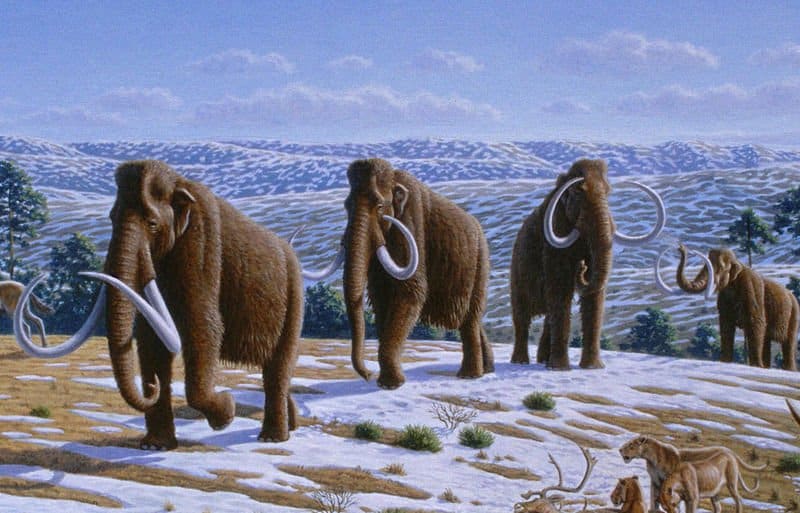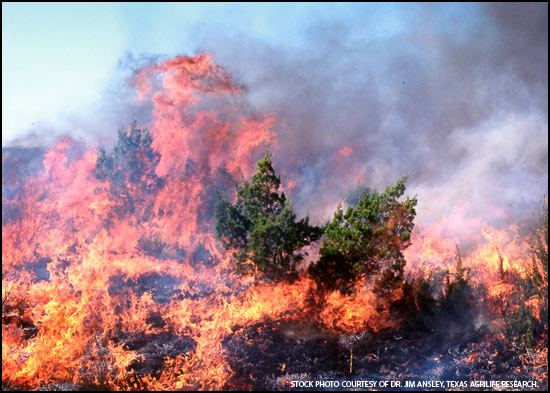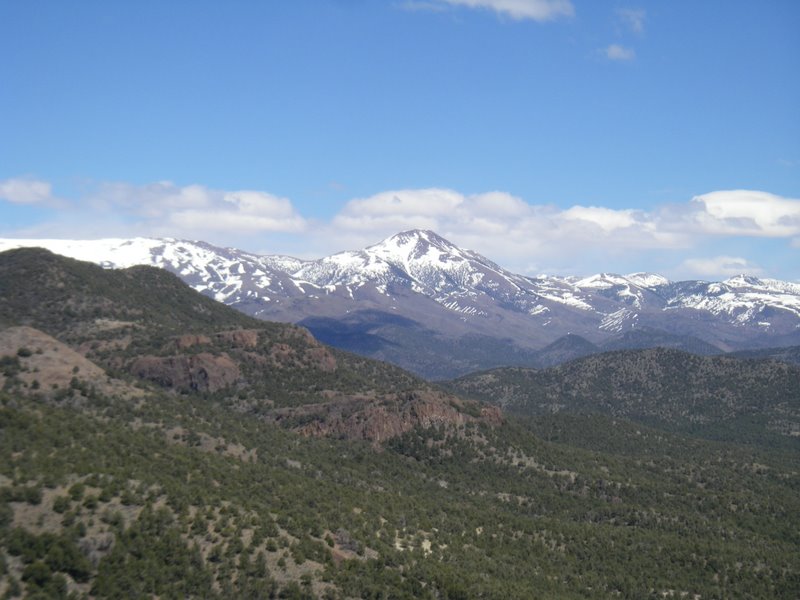
A forest might seem frozen-in-time unless it's a windy day, but on other timescales trees are quite active. Many plants move in circadian cycles or in response to sunlight. Plants with tendrils like bean plants will reach out into their surroundings with their tendrils until they find something to grab on to, like a bean pole, at which point they will steady themselves and continue to grow upwards. But these timescales are much too short for a forest to move. For a forest to move it may take many, many generations. Depending on the trees involved this may take tens, hundreds, thousands, or even tens of thousands of years. It seems, trees might just have a different sense of time than we do. The human perspective is limited by the fact that most of us will only live 80 years or so. A juniper in California is believed to be over 3,000 years old and it isn't unusual for local Pinyons and Junipers to reach several hundreds of years old. This still isn't very old compared to the age of the Earth (~4.5 billion years old). It is hard to imagine how much change has occurred over such a long history. Regardless, Pinyon-Juniper forests are dynamic when viewed at a speed of a hundred years per second, moving north and south, east and west, up mountains and then down again as the environment changes.
It's hard to know what the landscape was like a thousand years ago, or ten thousand, or a million, or a billion, but there is evidence that the majority of Pinyons and Junipers were living much farther south than today, only reaching as far North as Arizona, by the end of the last ice age 12,000 years ago (it's weird to think that during this time period giant sloths, wooly mammoths and saber toothed cats might've been moving amongst the same kind of Pinyon-Juniper forests that we see today. Things change fast!). It would be interesting to see if, back in the ice age, the Pinyons and Junipers grew to the same size or if they even looked the same as modern versions, knowing that climate and species-interactions affect the expression of genes and thus the way the trees would've looked.

Today, Pinyons and Junipers can be found from Mexico to Montana @ altitudes from 3500'-9000' in dry environments receiving ~10"-22" of precipitation a year. Generally the forests are composed of Colorado Pinyon with one or a combination of One-Seed Juniper, Utah Juniper, Alligator Juniper, and Rocky Mountain Juniper.
As the climate changes, organisms change their ranges in response. Also, when ecosystem composition changes or when the relationships between organisms changes, oftentimes so do the ranges of the organisms involved directly or inadvertently. These ecosystem, compositional changes and range-shifts can happen quite fast (hundreds or thousands of years) compared to geologic time scales (millions and billions of years). Thus, 10,000 years from now the junipers and pinyons might have moved to other areas of the continent.
More recently, meaning from 12,000 years ago until up to about 150 years ago, immigrants from Asia (the Native Americans) helped shape the range of the Pinyon-Juniper forest by cutting it down for firewood, using the pine nuts of the pinyons for a major food source as well as not controlling fires as stringently as we do today. With the arrival of European and American explorers, pioneers and many other immigrants, tree densities initially decreased especially during the mid-nineteenth century when many Pinyons were cut down. This was done for two reasons: For one, it undermined many Native American groups who used pine nuts in the Great Basin for a major food staple in their diet. Secondly, the pinyons were used to make charcoal for ore-processing. Eventually, these activities were discontinued and the Pinyon-Juniper forest began to increase its range and density. Pinyon-Juniper forests have expanded their ranges up-slope into ponderosa pine forests and down-slope into grass and shrub communities (especially sagebrush steppe). Much of this recent expansion can be attributed to our controlling wildfires, overgrazing grasslands and shrub-lands with domestic herds, and human-induced climate change with its corresponding increased atmospheric concentrations of carbon dioxide.
For the most part, Pinyons and Junipers have a hard time getting their offspring to move to new areas and for their seeds to germinate without a little help. Thus Pinyon-Juniper forest movement is actually the result of the activity of symbiosis. For Pinyons, the Pinyon Jay is the major disperser of seeds. It takes about 2.5 years for the Pinyon seeds to mature. The Pinyon Jay uses the mature Pinyon pine nuts as a food source, but it also has a useful (useful for the Pinyons) habit of burying the seeds for storage. This is especially useful for the Pinyons if the Pinyon Jay forgets about its stashes (not so useful for Pinyon Jays, but it seems one's mistake is another's fortune). These buried seeds have the best chance of germinating and growing to adulthood. Indeed, Pinyon seeds will rarely germinate in the wild unless they are cached by jays or other animals. It seems that the Pinyon Jay has a habit of burying these stashes of seeds at the base of Juniper trees. If you walk through a Pinyon-Juniper forest you often see the Pinyon trees growing right next to the Junipers, as if they were growing from the same hole. This is because Pinyons need nurse plants to grow and Junipers tend to be nurse plants for Pinyons. A nurse plant according to wikipedia "is one with an established canopy, beneath which germination and survival are more likely due to increased shade, soil moisture, and nutrients. Thus, the relationship between seedlings and their nurse plants is commensal. However, as the seedlings grow into established plants, they are likely to compete with their former benefactors for resources."

For Junipers, Jackrabbits and rodents (and coyotes to a lesser degree) are the main seed dispersers. Depending on the species of Juniper, the seeds and fruits may take 1,2 or 3 years to mature. The scarification of the seeds that occurs in the guts of the animals who eat the berries of the Juniper, as well as the excrement the seeds get balled up with before being dropped off at some new location in the environment all seem to be necessary for the successful germination and propagation of Junipers.

Many other animals use Pinyon-Juniper forests for habitat like Deer, Elk, Magpies, etc. It is also important habitat for many winter-migrating birds.
Many farmers, ranchers, range-managers and others see the expansion of Pinyon-Juniper forests as a nuisance, even as a danger, because it is a fire hazard and crowds out grasses and shrubs for grazing of domestic animals.
Various studies show, however, that though overly dense stands of Pinyon-Juniper trees do in fact crowd out grasses and shrubs, and can pose a fire hazard, their complete elimination doesn't provide the healthiest habitat either. Creating a patchwork, savannah-like forest seems to provide the most habitat for native animals and plants who are reliant upon these forests while also maximizing the amount of grasses and shrubs for grazing purposes. If the trees are cut too thin or dispersed, they can't easily reproduce and replace themselves with newer generations nor can they provide adequate cover for animals and birds who use these trees to hide, rest, shelter, and nest. Before we began to micro-manage wildfires, it seems that Pinyon-Juniper forests were evolved to withstand regular, but limited fires every 50-100 years, the forest requiring about 80-90 years to re-establish itself after such a fire. If fires are too frequent or too large the trees can't regenerate their populations (the Utah Juniper requires about 30 years to reach sexual maturity).

After fires, the former Pinyon-Juniper forest goes through a many-years-long, ecological process of succession to get back to the forest ecosystem. The year of or directly after the fire only perennial grasses grow. After a few years, the perennial grasses start being joined by shrubs and after a decade or so grasses and shrubs are joined by trees. Oftentimes, in these circumstances, sagebrush serves as a nurse plant for young Junipers who will then in turn be nurse plants for Pinyons. As the trees get bigger they start displacing shrubs and grasses. Thus we see that even on a shorter timescale of just a few decades that the environment is still dynamic and shape-shifting. One species displaces another while paving the way for others to establish themselves. Because of ecological succession, if there isn't occasionally a fire, or some other disturbance, the Pinyon-Juniper forest will eventually crowd out many other species of grasses and shrubs which in turn support a whole community of other animals and plants. Thus for an ecosystem to be healthy and diverse, some disturbance is necessary.
As of late, we've been experiencing more frequent droughts. With human-induced and natural climate change an on-going process, we might even see more droughts. This is bad for Pinyons. One study I read found that Pinyons have a 6.5 times greater mortality rate than Junipers during and following droughts. This means that Pinyon-Juniper forests are slowly becoming Juniper-dominated forests, Junipers being more drought tolerant. This is bad for the organisms that depend upon Pinyons like Pinyon Jays, other avian seed-dispersers, rodents, rabbits, deer, fungal and bacterial symbionts, etc. as well as the Pinyon-Juniper community which will generally be affected in unpredictable ways.
If I've conveyed anything to you, I hope it is the fact that environments are dynamic and mobile. They change composition and direction in response to the climate and by the influences of interactions with other organisms (like humans!). While a community, like a flock of birds, may move very fast in response to a change in weather, migrating South for the Winter for instance, other communities, like a forest, are just as sensitive to local conditions, but they move much more slowly (with the help of seed dispersers), perhaps taking hundreds or thousands of years to shift their range. Locally, the community may change composition even faster after a disturbance such as a fire, going through a process of ecological succession.

Life is ever-dynamic and amazingly adaptable!
-Seth Commichaux
Sources Cited:
http://www.sagestep.org/educational_resources/bibliographies/articles/2002_MillerTausch.pdf
http://link.springer.com/article/10.1007/BF02856556#page-1
http://onlinelibrary.wiley.com/doi/10.1111/j.1365-2745.2005.01042.x/pdf
https://www4.nau.edu/direnet/publications/publications_b/files/barney_frischknecht_1974.pdf
http://pjdb.csfs.colostate.edu/Content/pdf/Gottfried_1994.pdf
http://en.wikipedia.org/wiki/Ecological_facilitation
http://en.wikipedia.org/wiki/Juniperus_osteosperma
http://en.wikipedia.org/wiki/Single-leaf_Pinyon
http://en.wikipedia.org/wiki/Pinyon-juniper_woodland
No comments:
Post a Comment